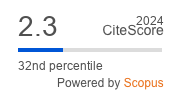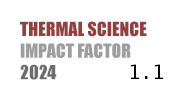THERMAL SCIENCE
International Scientific Journal
Thermal Science - Online First
online first only
Cost-optimal operation of hybrid heat pump systems with progressive electricity tariffs
ABSTRACT
pumps are very significant for wide application of renewable energy sources and sustainable heating. Their market penetration and extensive application depend on economic performance. Optimization of the operation parameters of energy systems with heat pumps can result in lower costs and higher savings. Heat pumps operate under different electricity pricing structures, which affect the optimization process. This paper presents a methodology for cost-optimal operation optimization of hybrid energy systems with heat pumps that can be used with progressive electricity tariffs and their combination with time-of-use tariffs. It relies on mixed integer linear programming and includes the constraints that handle electricity tariff rules. The paper illustrates an example of the application of this methodology to a heating system with an air-source heat pump and an auxiliary heater. The results show the impact of the energy prices and electricity tariff structures on the operating regimes and the values of the objective function. This approach can enhance the quality of the optimization results and improve the comprehension of cost-optimal operation regimes.
KEYWORDS
PAPER SUBMITTED: 2025-01-30
PAPER REVISED: 2025-02-19
PAPER ACCEPTED: 2025-02-26
PUBLISHED ONLINE: 2025-04-05
- ****, The Future of Heat Pumps, International Energy Agency, Paris, France, 2022, www.iea. org/reports/the-future-of-heat-pumps
- Adebayo, P., et al., Development, modeling, and optimization of ground source heat pump systems for cold climates: A comprehensive review, Energy and Buildings 320 (2024) 114646, DOI: https: //doi.org/10.1016/j.enbuild.2024.114646
- Topi´c Božiˇc, J. et al., Life cycle assessment of energy green transition goals in Slovenia and Serbia. Heat Pump Example, Thermal Science 28 (2024), No. 6A, pp. 4709-4721, DOI: doi.org/10. 2298/TSCI240618222T
- Vuˇckovi´c, G. D. et al., Air-source heat pump performance comparison in different real operational conditions based on advanced exergy and exergoeconomic approach, Thermal Science 25 (2021), No. 3A, pp. 1849-1866, DOI: doi.org/10.2298/TSCI200529237V 12
- Aryanfar, Y. et al., A competitive study of a geothermal heat pump equipped with an intermediate economizer for R134a and R513a working fluids, Thermal Science 27 (2023), No. 6B, pp. 5025-5038, DOI: doi.org/10.2298/TSCI230305133A
- Kossi, P., Rama, M., Improving the accuracy of heat pump feasibility assessment, Thermal Science 28 (2024), No. 5B, pp. 4381-4394, DOI: doi.org/10.2298/TSCI2405381K
- Joki´c, A. I. et al., Feasibility of closed loop ground source heat pump for residential heating and cooling applications in Serbia, Thermal Science 24 (2020), No. 2A, pp. 965-976, DOI: doi.org/10.2298/ TSCI181219279J
- Pesola, A., Cost-optimization model to design and operate hybrid heating systems - Case study of district heating system with decentralized heat pumps in Finland, Energy 281 (2023) 128241, DOI: doi.org/10.1016/j.energy.2023.128241
- Krützfeldt H., et al., MILP design optimization of heat pump systems in German residential buildings, Energy and Buildings 249 (2021) 111204, DOI: doi.org/10.1016/j.enbuild.2021.111204
- Aguilera, J. J., et al., Operation optimization in large-scale heat pump systems: A scheduling framework integrating digital twin modelling, demand forecasting, and MILP, Applied Energy 376 (2024) 124259, DOI: doi.org/10.1016/j.apenergy.2024.124259
- Li, B., et al., Economy and energy flexibility optimization of the photovoltaic heat pump, system with thermal energy storage, Journal of Energy Storage 100 (2024) 113526, DOI: doi.org/10.1016/j. est.2024.113526
- Prasanna, A. et al., Recent experiences with tariffs for saving electricity in households, Energy Policy, 115 (2018), pp. 514-522, DOI: doi.org/10.1016/j.enpol.2018.01.044
- Kim, K. et al., Public preferences and increasing acceptance of time-varying electricity pricing for demand side management in South Korea, Energy Economics, 119 (2023), 106558, DOI: doi. org/10.1016/j.eneco.2023.106558
- S. Ouédraogo et al., Impact of electricity tariffs and energy management strategies on PV/Battery microgrid performances, Renewable Energy, 199 (2022), pp. 816-825, DOI: doi.org/10.1016/ j.renene.2022.09.042
- An, J. et al., Determining the optimal trading price of electricity for energy consumers and prosumers, Renewable and Sustainable Energy Reviews, 154 (2022), 111851, DOI: doi.org/10.1016/j.rser. 2021.111851
- Youn, H., Jin, H. J., The effects of progressive pricing on household electricity use, Journal of Policy Modeling, 38 (2016), 6, pp. 1078-1088, DOI: doi.org/10.1016/j.jpolmod.2016.06.001
- Quan, S. J., Kim, K., Did new electricity progressive tariff system change energy usage pattern in Seoul apartments? Evidence from integrated multisource dataset and combined analytical models, Energy and Buildings, 287 (2023), 112979, DOI: doi.org/10.1016/j.enbuild.2023.112979
- Matar, W., Households' response to changes in electricity pricing schemes: Bridging microeconomic and engineering principles, Energy Economics, 75 (2018), pp. 300-308, DOI: doi.org/10.1016/ j.eneco.2018.08.028
- Bae, S., Nam, Y., Feasibility analysis for an integrated system using photovoltaic-thermal and ground source heat pump based on real-scale experiment, Renewable Energy, 185 (2022), pp. 1152-1166, DOI: doi.org/10.1016/j.renene.2021.12.094 13
- Jung, S. et al., An optimal scheduling model of an energy storage system with a photovoltaic system in residential buildings considering the economic and environmental aspects, Energy and Buildings, 209 (2020), 109701, DOI: doi.org/10.1016/j.enbuild.2019.109701
- Kang, H. et al., Reinforcement learning-based optimal scheduling model of battery energy storage system at the building level, Renewable and Sustainable Energy Reviews, 190 (2024), Part A, 114054, DOI: doi.org/10.1016/j.rser.2023.114054
- Dou, Z. et al., Innovative energy solutions: Evaluating reinforcement learning algorithms for battery storage optimization in residential settings, Process Safety and Environmental Protection, 191 (2024), Part B, pp. 2203-2221, DOI: doi.org/10.1016/j.psep.2024.09.123
- Kang, H. et al., Multi-objective sizing and real-time scheduling of battery energy storage in energysharing community based on reinforcement learning, Renewable and Sustainable Energy Reviews, 185 (2023), 113655, DOI: doi.org/10.1016/j.rser.2023.113655
- Zhang, R. et al., Peer-to-peer trading price and strategy optimization considering different electricity market types, tariff systems, and pricing models, Energy and Buildings, 300 (2023), 113645, DOI: doi.org/10.1016/j.enbuild.2023.113645
- ****, Energy Sector Development Strategy of the Republic of Serbia up to 2040 with Projections up to 2050, Official Gazette of the Republic of Serbia, No. 94 (2024) (In Serbian)
- Stojiljkovi´c, M. M., et al., Greenhouse gases emission assessment in residential sector through buildings simulations and operation optimization, Energy 92 (2015), Part 3, pp. 420-434, DOI: https: //doi.org/10.1016/j.energy.2015.05.021
- Stojiljkovi´c, M. M., Bi-level multi-objective fuzzy design optimization of energy supply systems aided by problem-specific heuristics, Energy 137 (2017), pp. 1231-1251, DOI: doi.org/10.1016/j. energy.2017.06.037
- ****, Gurobi Optimizer Reference Manual, Gurobi Optimization, LLC, 2024, www.gurobi.com, [accessed 10-Dec-2024]
- ****, EnergyPlus, Energy Simulation Software, energyplus.net/, [accessed 10-Dec-2024]
- Shmroukh, A. N. et al., Adsorption working pairs for adsorption cooling chillers: A review based on adsorption capacity and environmental impact, Renewable and Sustainable Energy Reviews 50 (2015), pp. 445-456, DOI: doi.org/10.1016/j.rser.2015.05.035
- Krzywanski, J. et al., Adsorption chiller in a combined heating and cooling system: simulation and optimization by neural networks, Bulletin of the Polish Academy of Sciences Technical Sciences 69 (2021), No. 3, e137054, DOI: doi.org/10.24425/bpasts.2021.137054
- Sztekler, K. et al., Performance Evaluation of a Single-Stage Two-Bed Adsorption Chiller With Desalination Function, Journal of Energy Resources Technology 143 (2021), No. 8, 082101, DOI: doi.org/10.1115/1.4048771

